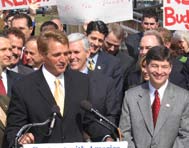Article from: www.thenewspaper.com/news/19/1965.asp
9/12/2007
Report Documents Impact of Earmarks on Transportation Funding
Report documents the cost of transportation earmarks as members of Congress fight uphill battle to stop them.
 Billions of dollars are being diverted every year from essential road projects through congressional earmarks, according to a report released Friday by the Inspector General of the US Department of Transportation. Senator Tom Coburn (R-Oklahoma) had requested the independent analysis of the effect of congressional special projects in advance of yesterday's Senate debate on transportation funding priorities.
Billions of dollars are being diverted every year from essential road projects through congressional earmarks, according to a report released Friday by the Inspector General of the US Department of Transportation. Senator Tom Coburn (R-Oklahoma) had requested the independent analysis of the effect of congressional special projects in advance of yesterday's Senate debate on transportation funding priorities.
The inspector general counted 8056 earmarks worth $8.54 billion within last year's transportation budget. The majority of these, 6556 earmarks, directed the Federal Highway Administration (FHWA) to spend $5,675,100,200 -- fifteen percent of the agency's 2006 budget -- on projects hidden from public scrutiny in the text of laws, in conference reports and in the reports accompanying the 2005 transportation bill known as SAFETEA-LU. An earmark allows an individual member of Congress to identify a need in his district and bypass traditional federal and state planning procedures. This turns something that might previously have been a low-priority project within the state into a mandatory top priority.
"The American people understand that transportation earmarks often have more to do with a politician's re-election campaign than the true priorities of each state's department of transportation," Coburn said. "If Congress had directed the money we spent on pork in the 2005 highway bill to maintenance we could have repaired more than 30,000 structurally deficient bridges."
In 2006, for example, a significant $813.9 million chunk of federal gas tax money was diverted to the Federal Transit Administration to be spent purchasing or replacing buses in congressional districts specified in 1097 separate earmarks. The Transportation Department's inspector general questioned the wisdom of the process.
"Earmarks may not be the most effective or efficient use of funds," the inspector general wrote.
Coburn yesterday proposed an amendment that would have placed a moratorium on all earmarks in the Fiscal Year 2008 Transportation and Housing appropriations bill, using the gas tax money saved to shore up the nation's structurally deficient bridges. Coburn's language would allow the earmarks to return once the bridges were safe, but the proposal failed on a 14-82 vote. In the House, Representative Jeff Flake (R-Arizona) intends to introduce his own legislation to prohibit states with deficient bridges from diverting motorist gas tax funds into projects including bike paths, transportation museums and road beautification projects.
"There's no question that we have infrastructure needs that aren't currently being met," said Flake. "However, those needs aren't being met because Congress lacks the resources, but rather because Congress is mismanaging transportation funding."
The congressional budget hawks found an ally in the White House this week which issued a statement strongly opposing the Senate funding bill because, "it includes an irresponsible and excessive level of spending." The president has also called on Congress to cut back on wasteful earmarks. At least one outside groups has joined in to urge that Congress use gas tax money on infrastructure priorities, not re-election priorities.
"Politicians often ask taxpayers to make sacrifices through higher taxes, but it is time for politicians to do the sacrificing by giving up their special-interest pork projects." Club for Growth President Pat Toomey said. "I challenge any senator to stand on the floor of the Senate and explain why his local museum or bike path is more important than fixing America's bridges."
A full copy of the Inspector General's report is available in a 178k PDF file.
Article Excerpt:Conclusions from the DOT Inspector General's report:
- First, earmarks can reduce funding for the states' core transportation programs.
- Second, earmarks do not always coincide with DOT strategic research goals.
- Third, many low priority, earmarked projects are being funded over higher priority, non-earmarked projects.
- Fourth, earmarks provide funds for projects that would otherwise be ineligible.
- Fifth, earmarks can disrupt the agency's ability to fund programs as designated when authorized funding amounts are exceeded by overearmarking.
Source: Review of Congressional Earmarks Within Dept of Transportation Programs (US Department of Transportation, 9/7/2007)
Permanent Link for this item
Return to Front Page
 Billions of dollars are being diverted every year from essential road projects through congressional earmarks, according to a report released Friday by the Inspector General of the US Department of Transportation. Senator Tom Coburn (R-Oklahoma) had requested the independent analysis of the effect of congressional special projects in advance of yesterday's Senate debate on transportation funding priorities.
Billions of dollars are being diverted every year from essential road projects through congressional earmarks, according to a report released Friday by the Inspector General of the US Department of Transportation. Senator Tom Coburn (R-Oklahoma) had requested the independent analysis of the effect of congressional special projects in advance of yesterday's Senate debate on transportation funding priorities.